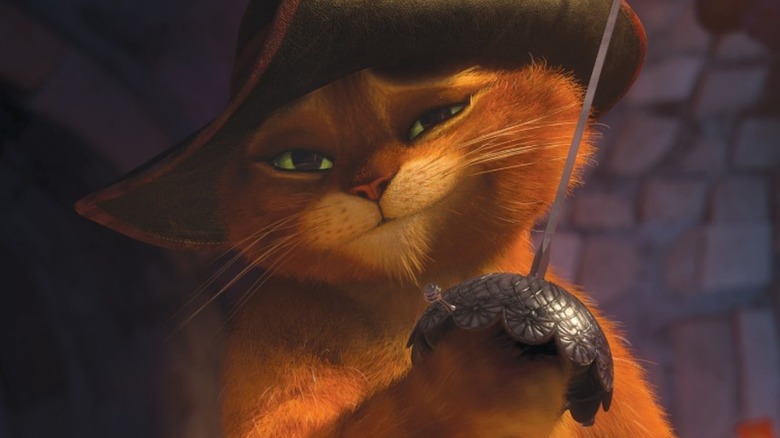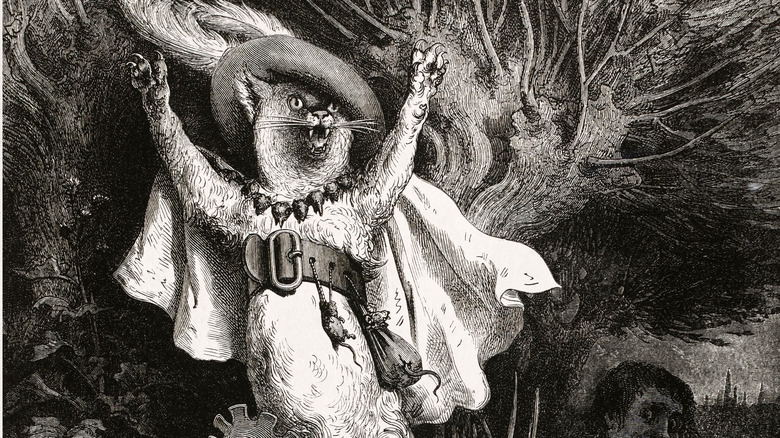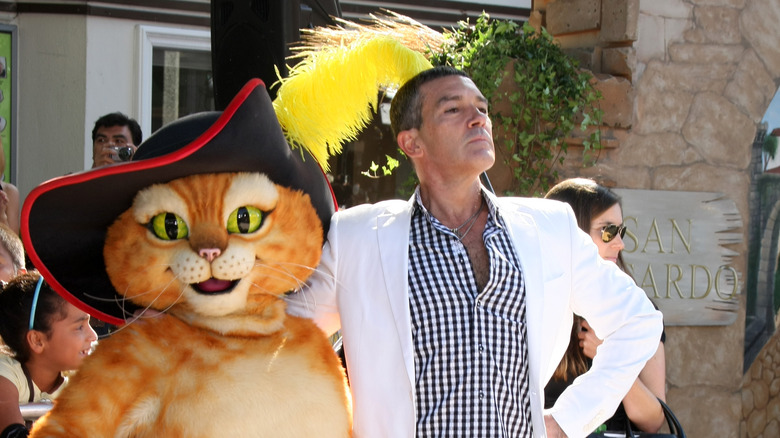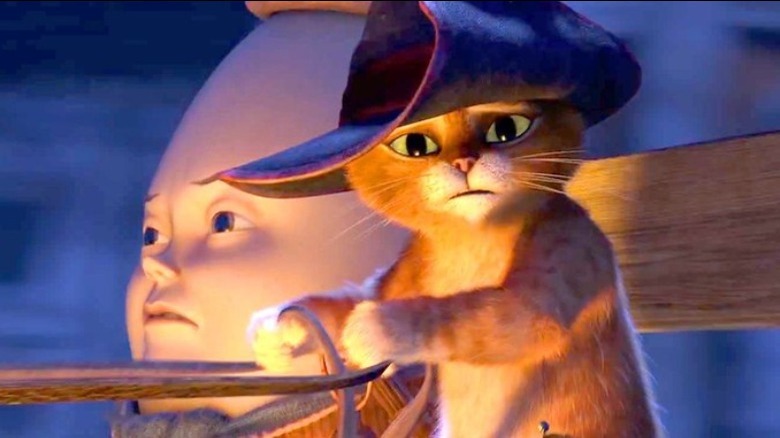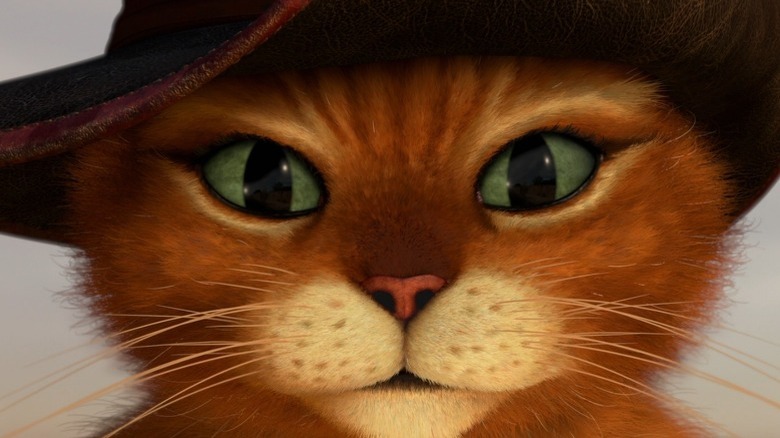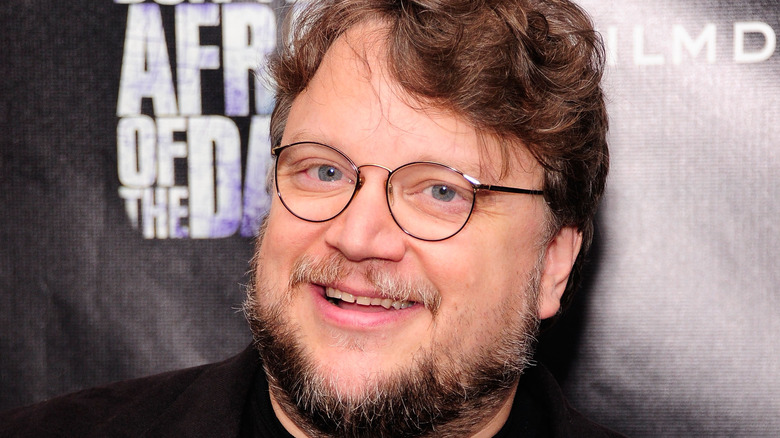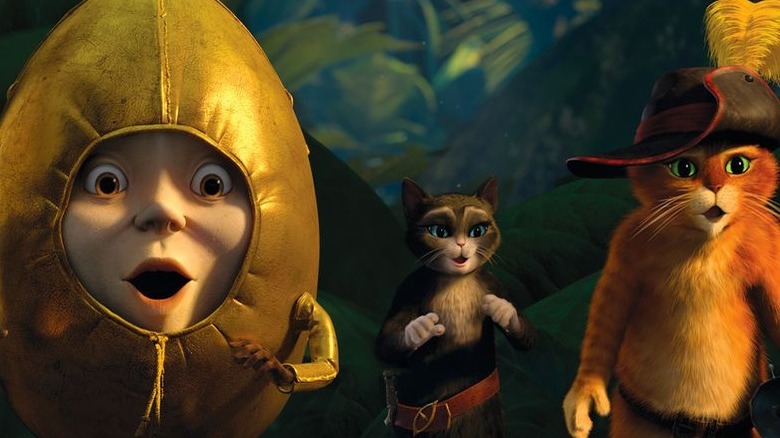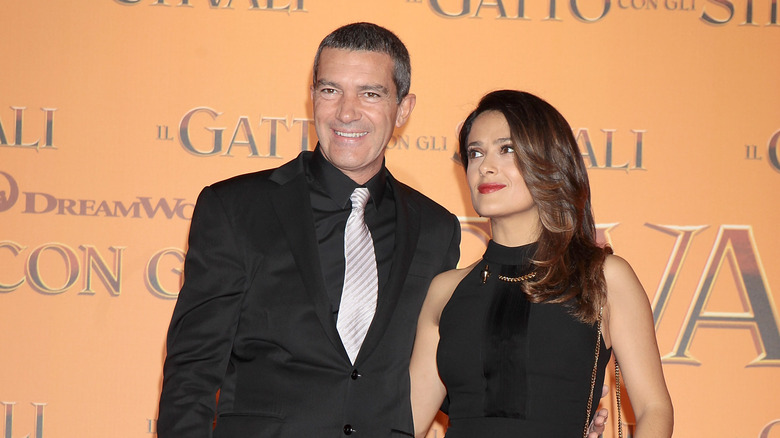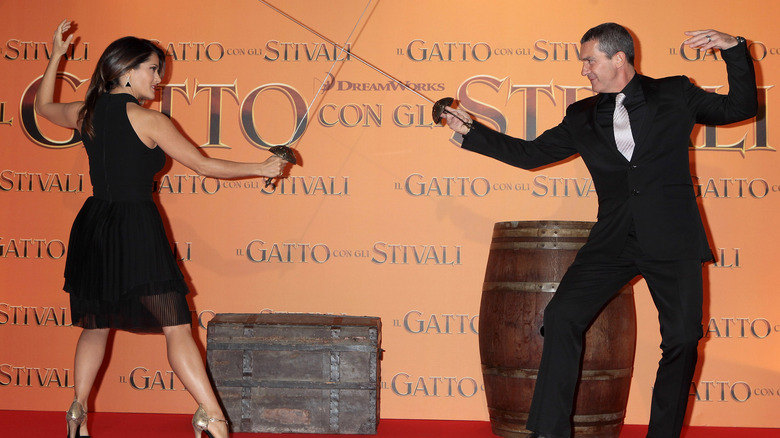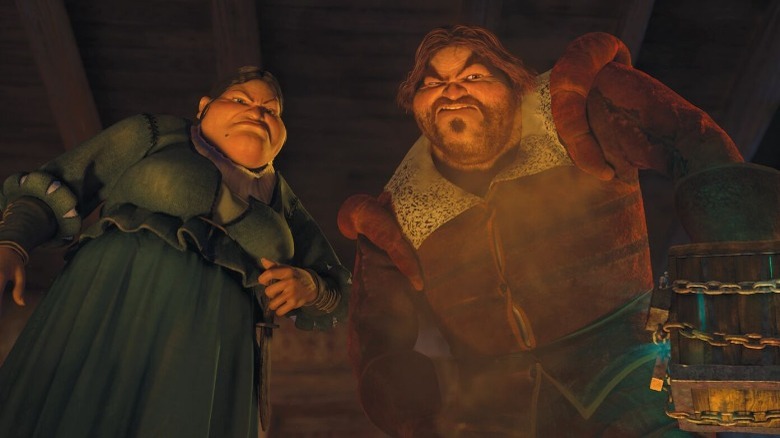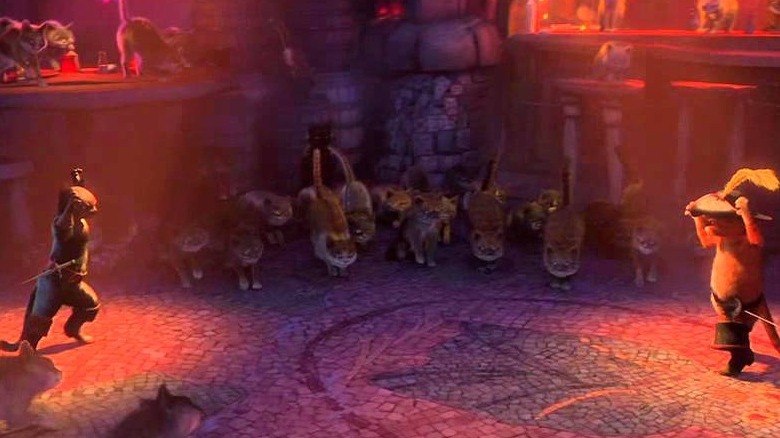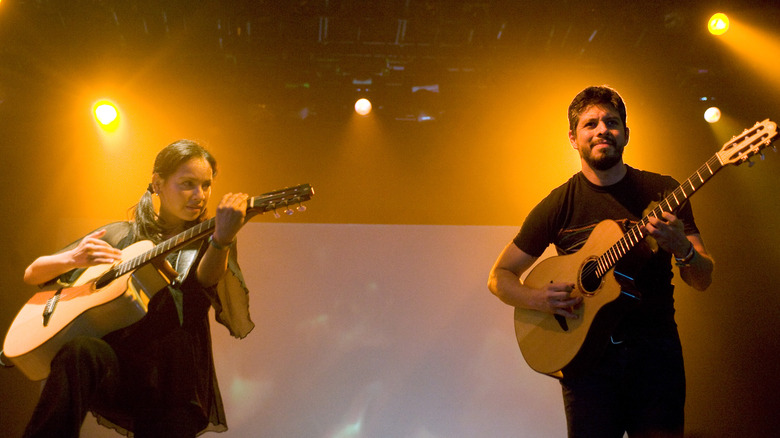Puss In Boots:12 Facts About The Shrek Spin-Off For Feline Fans Everywhere
It's funny how irony works. Released in 2001, "Shrek" wasn't so much an adaptation of William Steig's children's book so much as an excuse to satirize Disney cartoons (including surprisingly adult jokes for a kid's movie). "Shrek" was so successful it became a four-film franchise, and with the spin-off movie "Puss in Boots" it became a bonified cinematic universe. A fan-favorite supporting character, Puss in Boots proved able to carry an entire movie of his own.
Now that the long-awaited follow-up "Puss in Boots: The Last Wish" has enjoyed a surprisingly extended life at the box office on the strength of its sincere meditation on mortality, it's worth revisiting the story of the original "Puss in Boots." A decade after the feline was introduced in "Shrek 2," Puss had become a legend of his own. "Puss in Boots," forging a new identity separate from the snark and arch comedy that defined the 2000s, was free to dabble in more Pixar-like emotional depth and character work. Here are 12 facts about "Puss in Boots" fans of fabled felines everywhere should find fundamental.
The character's origin was changed from the original Italian and French
Centuries before the "Shrek" franchise, the story of Puss in Boots was a European folk tale retold through the ages in the oral tradition. Its earliest printed version dates to 16th century Italy, but the story was popularized widely in France, with Charles Perrault's "Histoires ou contes du temps passé, avec des moralités." The book is perhaps better known as "Mother Goose Tales," and the book is also responsible for making characters like Cinderella, Red Riding Hood, and Sleeping Beauty household names. But of course, the most important character of all is the dashing Puss in Boots.
But once Antonio Banderas was cast for the role in "Shrek 2," the character's origin was changed to Spain to reflect the actor's own Spanish heritage. Puss in Boots' first appearance is essentially an extended sight gag, pairing Banderas's deep, confident voice with the body of a diminutive cat. Filmmakers for "Puss in Boots" found themselves with the need to tell an entirely new origin story for Puss in Boots, since Perrault's version of the fable involves a tricky cat helping a miller's son marry a princess.
Antonio Banderas was surprised to be offered a voice acting role
Antonio Banderas would gain acclaim in his early career in Spain, most notably in the films of auteur Pedro Almodóvar, but he arrived in Hollywood in the early 90s speaking only minimal English. As he told the New York Times, "I couldn't speak the language. At all. I did my first movies learning the lines phonetically, and I had an interpreter to talk to the director. Suddenly, years after, to be called for the use of my voice only, it was interesting. And pretty weird."
By the time "Shrek 2" came out in 2004, not only was Banderas's English impeccable, but his still-noticeable accent had become the opposite of a liability. His iconic performances in movies like "Interview with the Vampire," "Desperado" and "The Legend of Zorro" are what made his voice instantly recognizable, to the point that he would be cast as Puss in Boots specifically to give the character a built-in personality. Nowadays he's just as associated with voice roles (chiefly Puss in Boots and the Nasonex bee) as with his famous live action parts.
It was originally planned to be released straight to DVD
Though it's hard to imagine from this side of history, after "Puss in Boots" made a cool half-billion at the box office, it was originally planned as a straight-to-DVD release. In the tradition of straight-to-video Disney sequels you never knew existed, DramWorks was going to confine Puss in Boots's origin story to the bargain bin along with a spin-off about the penguins from "Madagascar," which was the franchise that seemed poised to replace "Shrek" as the real box office cash cow in the mid-2000s.
A Variety report on the state of DreamWorks projects from 2005 stated that "The Penguins of Madagascar" would be the studio's "second direct-to-video pic after 'Shrek' spinoff 'Puss in Boots,' which has been pushed back from 2007 to 2008." It would take the movie a few more years to finally come out, by which time it was clear that DVD sales no longer had a bright future with the rise of streaming: 2011 was the same year that Netflix Instant and its DVD-rental arm split into separate services, for example. "Puss in Boots" would eventually have a spin-off of its own, "The Adventures of Puss in Boots" — a TV show streaming on Netflix, of course.
Puss in Boots ditched the tongue-in-cheek parody of the Shrek franchise
"Puss in Boots" does have some elements of the "Shrek" franchise. Notably, it plays with fairy-tale conventions by having grotesque adult versions of Jack (Billy Bob Thornton) and Jill (Amy Sedaris) as the villains. Though it partakes in the practice of toying with the foundations of fairy tales, "Puss in Boots" opted for a more heartfelt and straightforward tone than the PG edge of the reference-happy "Shrek". To give its swashbuckling hero a proper origin story, the movie had to take the legend of Puss in Boots at least half as seriously as the legend himself.
In an interview with Fantasy Magazine, writer-director Chris Miller explained the desire to distinguish the spin-off from its source. "Now we knew that we were going to have the fairy tale world as a backdrop in 'Puss in Boots,' we wanted to make sure we didn't end up just parodying them. We wanted to take the original stories and put a new spin on them ... since we weren't satirizing anything, we wanted to make sure the film was all about character and interesting relationships, and let those drive the comedy."
Guillermo Del Toro helped shaped the Humpty Dumpty character
Guillermo Del Toro, no stranger to re-imagining fairy tales himself with his Academy Award-nominated "Guillermo Del Toro's Pinocchio," received an executive producer credit on "Puss in Boots." Del Toro was also instrumental in shaping the character of Humpty Dumpty (Zach Galifianakis). As part of an overall deal with DreamWorks that would eventually lead to the creation of the "Trollhunters" franchise, Del Toro also consulted with current in-house productions and became a monthly creative guru that director Chris Miller could bounce ideas off. We have no doubt having a force like Del Toro was a key part of the success of "Puss in Boots."
Speaking with the Wall Street Journal, Del Toro said that "Puss in Boots" was "the first movie I was really able to affect as part of the team." He was instrumental in turning Humpty into a Leonardo da Vinci-like inventor, or "an ingenious freak of nature." Del Toro also insisted that the ending of the movie be written to incorporate redemption for Humpty, in order to make the story more complex, rather than a simple dichotomy between heroes and villains. As a final contribution, Del Toro even provided the voice for the small role of the Commadante of San Ricardo, Puss in Boots's fictional Spanish hometown.
The Giant was killed off-screen to subvert expectations
Although it wasn't as tongue-in-cheek as "Shrek," "Puss in Boots" did take a measure of pride in sticking to the same tradition of subverting traditional fairy tale expectations. Childhood legends Jack and Jill are brutish, adult outlaws. The benevolent figure of Mother Goose becomes a two-story-tall monster that nearly destroys the town. But the biggest challenge in coming up with an original take on a fairy tale legend was the largest character of them all (literally): the giant that lives at the top of the beanstalk. And "Puss in Boots" wanted to ensure that its approach was different from other films.
Director Chris Miller told Animated Views "we wanted to just make a straight-up giant, like a real fairy tale legendary giant. And no matter how hard we tried to twist the character there was something about it that felt so expected. Once you did see him it wasn't surprising, no matter what we did." So instead, in the ultimate subversion of expectations, the giant was killed off-screen, resulting in just another red herring obscuring Humpty as the true villain of the plot.
Puss in Boots was a quiet step forward for Latino representation
There are quite a few movies where characters with strong accents are evil. Think of the greatest James Bond villains: how many of them speak crisp English? Speaking to Collider, Antonio Banderas revealed that he was told as much on his first Hollywood set: "When I first came to America... I did 'The Mambo Kings,' and somebody on the set said to me, 'If you're gonna stay here, you're gonna play bad characters. You're gonna be the bad guy, in movies.'" While he and frequent co-star Salma Hayek would go on to careers where they played more than just villains, "Puss in Boots" gave them a chance to advance Latino representation in terms of children's movies as well.
Banderas went on: "So, we are actually very proud that our characters are Latinos, and I think it's good for diversity and cultural interaction. This movie is going to be seen by kids, and they don't judge, in those terms. They're going to watch the movie and see that the heroes actually have a strong accent, and that is good." In both "Puss in Boots" and the sequel "The Last Wish," our heroes get the better of villains with impeccable English, in a complete reversal of a common movie trope.
Amy Sedaris improvised most of her dialogue
Two members of the "Puss in Boots" voice cast were comedians brand new to voice-over work: Zack Galifianakis as Humpty and Amy Sedaris as Jill. To take advantage of their backgrounds in stand-up comedy and improv respectively, director Chris Miller gave them free rein to improvise lines in the vocal booth, which yielded particularly impressive results, especially in Sedaris's case. It apparently got to the point where the writers relied on Sedaris's off-the-cuff abilities instead of finding lines they were happy with in advance. It turned out to be a savvy move, as Jill provides some very valuable comic relief.
Miller revealed to Animated Views that "with Amy we'd write lines that we knew were just in the ballpark that we needed and honestly she would give us fifty different versions of something, and that's no exaggeration." With so many options to choose from, the vast majority of the part of Jill was made up by Sedaris on the spot. Per Miller, "probably ninety percent of her dialogue came out of her brain." Galifianakis told Collider that for his part he improvised liberally but "I don't know how many they used in the movie 'cause it's a kids' movie and I probably just went off the rails a little bit."
Antonio Banderas and Salma Hayek recorded their lines together
Ever since Salma Hayek in her breakout role joined Antonio Banderas in "Desperado," the pair have been associated with one another and often reunited onscreen. They would go on to reprise their roles in the sequel "Once Upon a Time in Mexico," and co-star in movies like the anthology "Four Rooms" and the acclaimed biopic "Frida." For "Puss in Boots," they even were allowed a special exception to the normal way that voice roles are recorded for major studio animation. For the most part, voice actors are alone in a booth with only the director of the movie and an audio engineer or two to play off of, but Banderas thought it would be worthwhile to mix it up to take advantage of his and Hayek's unique chemistry.
In an interview with Movie Fanatic, he revealed that "I asked our director, Chris (Miller), to give us the opportunity to work together. So, we had a session together. Actually, I think it's some of the best stuff we did together and it made it into the movie. If we had done that individually, it would have been very difficult." Puss in Boots and Kitty Softpaws, in addition to being well-matched fencing and dancing partners, have a witty repartee that could only have been captured live in a room.
Billy Bob Thornton made his voice bigger for Jack
Arguably going back to the casting of Robin Williams in Disney's 1992 film "Aladdin," the practice of casting recognizable celebrities in animation has become more and more widespread. "Puss in Boots" and the "Shrek" franchise at large are certainly no exception. In practice, this often means that famous actors do voice work but aren't even asked to "do a voice" in any way — they often speak like themselves in order for people to recognize who it is. In an interview with Fandom Entertainment, Billy Bob Thornton says his assignment as Jack was simple: "I essentially didn't have to do much... I just kind of show up and start talking."
He did point out, however, that he modified his voice slightly to reflect the main difference between himself and his character: "I weigh 145 pounds, and this guy weighs 300 pounds or something." So to embody Jack he had to try and affect a more robust, booming version of his speaking voice to match the strength and power of the villainous Jack. Fortunately, he didn't have to fall down any hills for research.
The dance scenes had a real-life choreographer
"Puss in Boots" includes multiple dance sequences — a pivotal dance-off between Puss in Boots and Kitty when they meet, and a more romantic dance scene as the film closes. A real-life (human) choreographer was actually brought in during the animation process to make the dances more authentic: Lisa Gorenstein Miller, the director of the Helios Dance Theater in Los Angeles. Conveniently, and likely not coincidentally, she's also the wife of director Chris Miller.
Not only did she face the challenge of translating human movement to cat anatomy, but the cantina scene also had a particular constraint. Speaking with Trailer Addict, Gorenstein Miller pointed out that at that point in the story, the filmmakers "didn't want to reveal to the audience that Kitty was a girl. So as a choreographer, I had to make the movements more masculine, bravado, a little more aggressive than I would have normally for a woman character."
World famous flamenco duo Rodrigo Y Gabriela added flair to the cantina scene
In a wide-ranging interview with Animated Views, "Puss in Boots" composer Henry Jackman explained that the movie offered a unique opportunity for a fantasy film. Instead of the traditional symphonic score with a full orchestra, the setting and character-specific elements of "Puss in Boots" meant it could be distinguished with many different tones, incorporating the flavor of its Spanish inspirations. The result was a liberal use of solo guitar: Jackman said that "the use of solo instruments can really bring the melodies forward and it makes it closer and more intimate and more individual...on top of that, we had the added benefit of having Rodrigo and Gabriela play the guitar parts of the score which I wrote."
The Mexican-born acoustic guitar duo, who perform as "Rodrigo y Gabriela," actually rose to fame in Ireland after emigrating from Mexico in 1999. But they're pioneers in the genre of "nuevo flamenco," or flamenco fusion: music that blends a classical Spanish style with modern rock techniques. This made them the perfect artists to collaborate with on "Puss in Boots," as it also sought to combine Spanish heritage with a modern sensibility.
